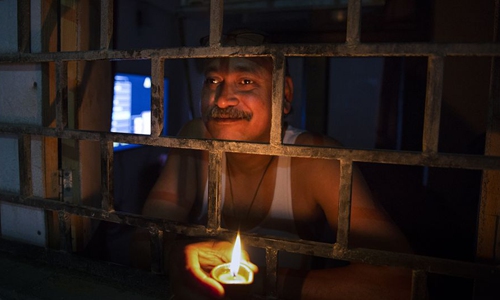India joins global rush to snap up medical supplies from China

An Indian man lights an earthen lamp on his balcony to mark the country's fight against the COVID-19 pandemic in New Delhi, India, on April 5, 2020.Photo:Xinhua
Indian companies and non-governmental organizations (NGOs) are following the global trend of snapping up medical supplies from China, the world's factory for such products.
That comes as the world sends procurement managers to buy a full array of medical supplies in China, with agents from the US and France reportedly debating "ownership" of medical materials on the tarmac at a Chinese airport last week.
Despite the fact that the Indian government has not sent out a request to the Chinese government to facilitate such trade and India's relatively small number of COVID-19 cases, Indian companies are on the move to procure medical supplies and at least one fully loaded plane will depart from Shanghai on Thursday or Friday, the Global Times has learned.
India is so far the only BRICS country that has not officially sent a request for Chinese medical supply assistance, according to Global Times research.
"We have been discussing with Chinese manufacturing companies the supply of personal protective equipment suits, goggles, infrared thermometers, CPAP (continuous positive airway pressure) machines, BiPAP (Bilevel Positive Airway Pressure) machines and ventilators," Indian businessman Arjun Bahri Dhawan told the Global Times on Thursday.
"We have a flight from Shanghai to Delhi later this week, if the factory can supply on time. We are trying hard to ship this as soon as possible," Dhawan said.
However, with the global buying rush, not all items are available for purchase at the moment. Dhawan's team has failed to secure any ventilators.
"Ventilators are a big, big problem. Factories have no stock. They are booked with orders for the next 45 days. The local traders in China are quoting a price of three times [the standard]," Dhawan said.
"We have heard that Indian government agencies are in touch with their Chinese counterparts for COVID-19 medical supplies, and some cargo flights were sent by the Indian government this week to bring such medical supplies from China," Mansoor Nadeem Lari, CEO of the India-based Silk Route Trade and Industry Development Corp, told the Global Times on Thursday, confirming the flight carrying made-in-China supplies.
The cost of the purchase will be paid by different levels of the Indian government, NGOs and corporations, and the goods will be distributed among governments and NGOs instead of through a normal retail channel, before they finally reach the Indian people, according to Dhawan.
To help India combat the virus, Chinese companies have also thrown in their support.
Two batches of donations from Chinese charity organizations the Jack Ma Foundation and the Alibaba Foundation arrived in Delhi on April 1, Chinese Ambassador to India Sun Weidong tweeted. The donation included protective clothing, masks, respirators and ventilators.
Chinese state-owned companies are also providing assistance to their Indian partners in the fight against COVID-19, Sun said. Fosun International has also donated items.
The civilian sector plays an equally important role [in fighting the pandemic], Dhawan said.
Due to the sudden surge in demand of medical items worldwide, supplies are hard to come by, with extremely volatile prices and some traders hoarding stock to profiteer, Dhawan said. But the main difficulty is finding ready available stock as most factories have sold out.
"As long as we get genuine suppliers with correct quality stock, we do not mind paying an extra premium," Dhawan said.
Chinese government is calling its enterprises to ramp up production and expand exports of medical supplies to help in the global fight against COVID19, while at the same time meeting domestic demand, an official with the Ministry of Industry and Information Technology said on Wednesday.
Global Times